How Christian Dior Revolutionized Fashion With His New Look
- Oops!Something went wrong.Please try again later.
- Oops!Something went wrong.Please try again later.
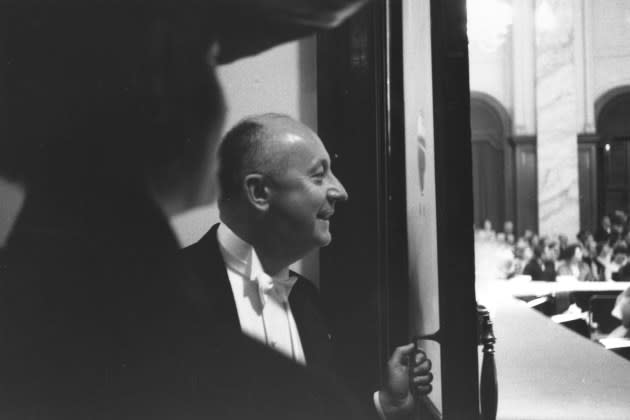
The birth of the house of Dior is the focus of the new Apple TV+ period drama “The New Look,” which focuses on how Christian Dior and his contemporaries navigated the horrors of World War II and resuscitated French haute couture.
“Monsieur Christian Dior, the stout and startled-looking grand vizier of the high-fashion Paris dressmakers, is the main reason most women look the way they do today,” Collier’s Weekly reported in 1955, eight years after the couturier set the fashion world spinning with his waist-cinching, fan-skirted New Look dresses.
More from WWD
Glenn Close, Maisie Williams Turn Out for 'The New Look' Premiere
The Golden Age of Couture Comes to Life in Apple TV's 'The New Look' With the Help of Dior
Within years of founding his house in 1947, Dior had become the locomotive of the French fashion industry, his designs spawning an empire that set the template for the modern fashion business, replete with such innovations as licensing, accessible products like stockings and fragrances, and collections tailored to certain markets.
By 1953, the business grossed a whopping $15 million annually, employed 1,500 people and accounted for 55 percent of all Paris couture exports.
Today, the brand is a jewel in the crown of luxury magnate Bernard Arnault, the founder of LVMH Moët Hennessy Louis Vuitton, who has owned Dior since 1984. Though LVMH does not break down revenues by brand, Bernstein analyst Luca Solca estimates that Dior brings in annual revenues of 15 billion euros from fashion and beauty, making it one of the world’s most powerful luxury brands.
Although his trajectory was cut short with his death in 1957, Dior cut a wide swath in fashion history, thanks to memorable designs that glorified female beauty and invoked desire around the world. For him, fashion was feeling. “It cannot be reasoned,” he once said.
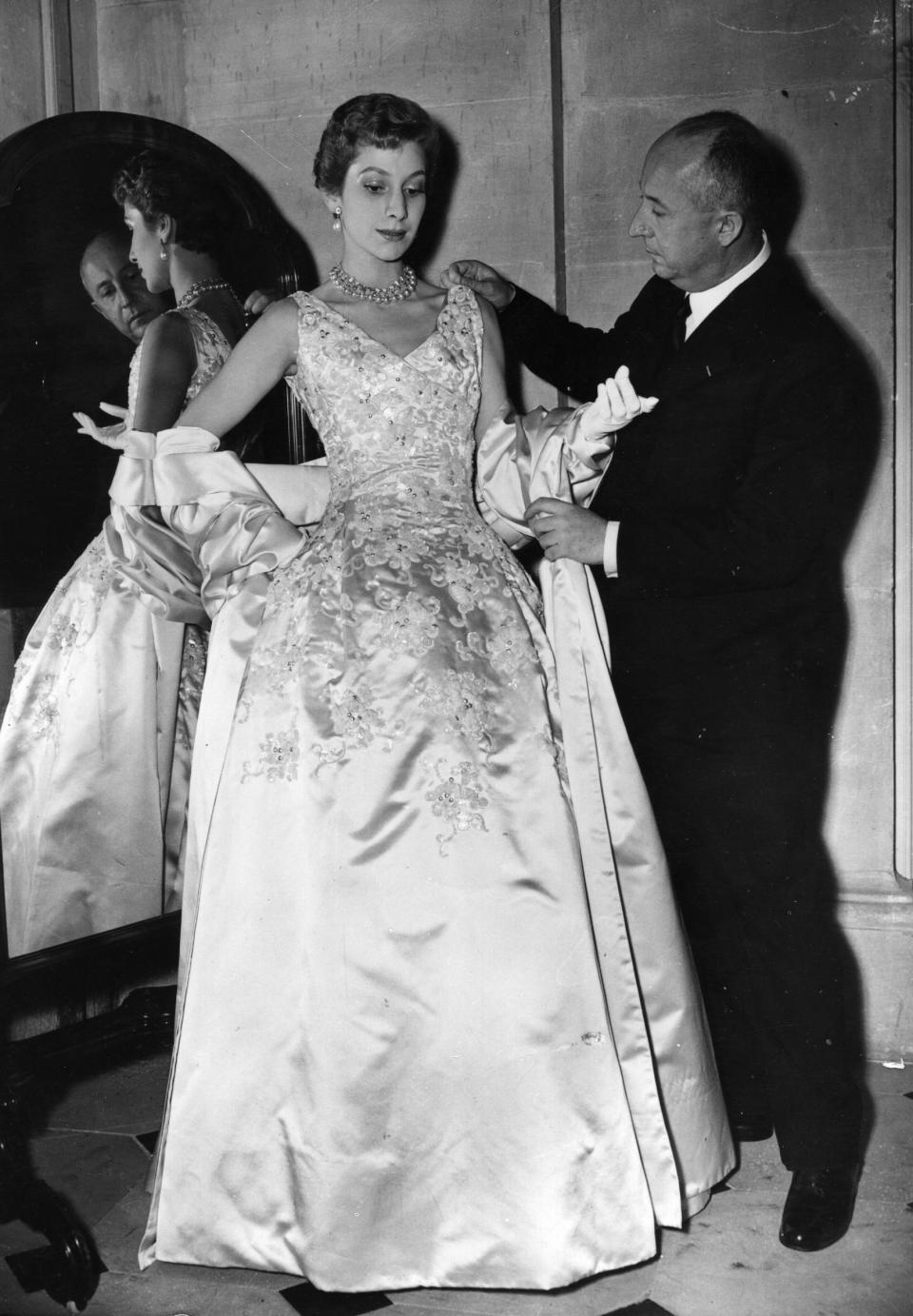
But his leap to the forefront of global fashion was not a given. He was born in 1905 in Granville, a provincial coastal town in the Normandy region of France, to an industrialist father, Maurice, and a housewife mother, Madeleine Martine.
Maurice Dior and family members ran a group of chemical companies, which landed the Dior name on such products as fertilizers.
Dior’s mother, transfixed by the refined traditions of the bourgeoisie, was known for her elegant outfits and dedication to a beautiful lifestyle, reflected in her furniture, interior decoration and flowers. That affected her five children, notably Christian, who loved gardening and fancy parties, and designed costumes for local events and carnivals. But he was frequently described as a moody, taciturn child, prone to solitude.
The family moved to Paris in time for Dior’s higher education, and his parents initially envisioned a diplomatic career for their son upon his graduation from the Institute of Political Sciences. But Dior’s interests were artistic, principally architecture, music, drawing and painting.
He opened a gallery in 1928 with an antique dealer friend, working with avant-garde artists such as Salvador Dalí, Alberto Giacometti, Pablo Picasso and Man Ray.
After his family lost its fortune in the Great Depression, Dior learned fashion drawing and started selling designs to magazines and couturiers including Jean Patou, Nina Ricci, Maggy Rouff and Balenciaga.
In 1938, he was hired by Robert Piguet as a draftsman, playing a role in the romantic fashions that dominated until World War II. Dior’s career was interrupted by the conflict, during which he served as a private first class in the engineering corps. He returned to Paris in 1941 and joined Lucien Lelong, then a leading French fashion house, where he worked with Pierre Balmain.
In his biography, “Christian Dior and I,” the designer recalled that he enjoyed his work at Lelong immensely. “I had neither the responsibility of putting my designs into production nor that of selling them,” he wrote.
Then came a chance encounter with a childhood friend and a director of the house of Philippe & Gaston, a dressmaker owned by Marcel Boussac, the French textile mogul known as the cotton king, who was looking for a designer to infuse new life into the business.
Initially stumped for suggestions, Dior ultimately proposed himself as a potential candidate. That was, until he inspected the business from top to bottom and decided Boussac would be wasting his time trying to restore Philippe & Gaston to its former heights.
“So many others before me had tried to resurrect once-famous names without success; the existence of a dressmaking house is burdened with uncertainties, and its lifespan is often far shorter than the men who run it,” Dior wrote. “I decided that I was not meant by nature to revive the dead.”
Ultimately, Dior found himself suggesting the creation of his own house, new from top to bottom, and built on the principles of luxury and craftsmanship — a proposition that piqued Boussac’s interest. “After the prolonged stagnation of the war years, I believed there was a genuine unsatisfied desire throughout the world for something new in fashion,” Dior wrote.
Dior was deeply superstitious. Before he accepted Boussac’s offer, he consulted his mystic, Madame Delahaye, who urged him to accept. But her endorsement wasn’t enough. Through Raymonde Zehnacker, his mentor at Lelong who would remain a lifelong friend, Dior got an appointment to see Grandma, another mystic. She is said to have shrieked, “This house will revolutionize fashion.”
Later that same evening, in March 1946, while walking down the Rue du Faubourg Saint-Honoré, Dior stumbled over something. It was a metal star with a hole in the middle. He took it as a sign. The next day he marched into Boussac’s office and the two were in business.
Boussac ponied up $500,000 to launch the brand and Dior took up residence at 28 Avenue Montaigne, which was being vacated by a hat shop.
Seeking to relieve women from wartime frugality and shapeless clothes, Dior devised ways to enhance feminine beauty. His proposition was greeted with rapturous applause and immediately embraced by such disparate women as singer Juliette Greco and stage actress Dominique Blanchard, who had a long skirt made of 80 yards of pleated white faille.
Carmel Snow, the editor of Harper’s Bazaar, baptized Dior’s first collection “New Look,” and it precipitated a stampede back to Paris for fashion — and, as noted, outcry in the city’s streets over what many, still struggling after the war, considered an extravagant use of precious cloth.
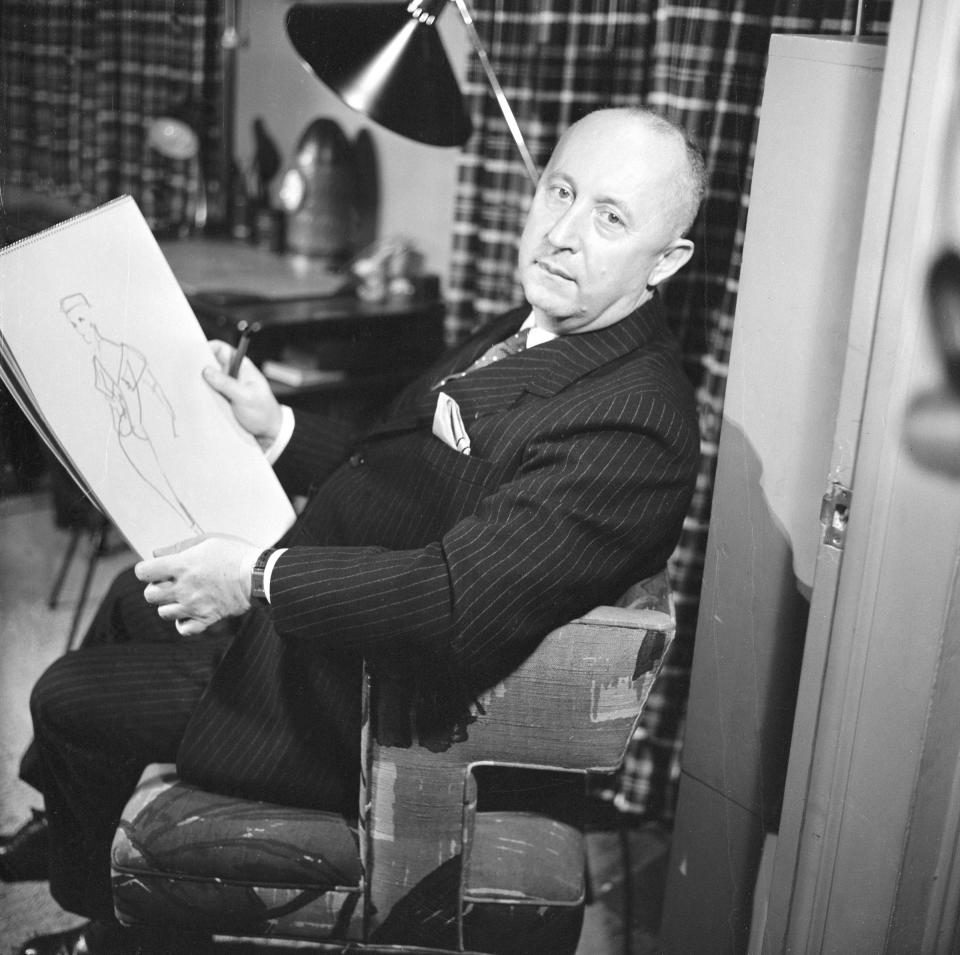
The business quickly expanded to neighboring buildings, the one at 30 Avenue Montaigne housing what in the early ’50s was the biggest luxury boutique in Paris. Many of the founder’s decorating codes — medallions, ribbons, cane work, houndstooth and panther prints — remain today.
He was the only Paris couturier to maintain significant licenses in foreign countries, acquiring 41 of them during his time at the house. He had operations in Australia, Canada, New Zealand, England and even Syria, to name a few. Besides his couture and ready-to-wear, he also created gloves, jewelry and men’s ties.
Despite a gentle and shy nature, Dior was a natural provocateur, whose drastic changes in silhouette often invoked controversy, outrage and numerous headlines, fanning his notoriety. “Gossip, even malicious rumors, are worth more than the most expensive publicity campaign in the world,” he figured.
His designs were widely copied, down to mass-produced housedresses, and were the guiding light for millions of women worldwide. After the New Look brought hemlines to the ankle, protests broke out in many of the places Dior traveled, including America.
In Paris, market women tried to attack models wearing lavish Dior dresses while they were being photographed. “I never guessed what an explosive quality my modest formula would prove to have in an age of compromise and laissez-faire,” the designer said. “I designed flower women — soft shoulders, full busts, waists as narrow lines and skirts as corollas.”
His famous customers included the Duchess of Windsor, Gloria Swanson, Marlene Dietrich and Zsa Zsa Gabor, and among his intimate social circle were artists Jean Cocteau, Sir Francis Rose and Christian Bérard, and composers Darius Milhaud and Francis Poulenc.
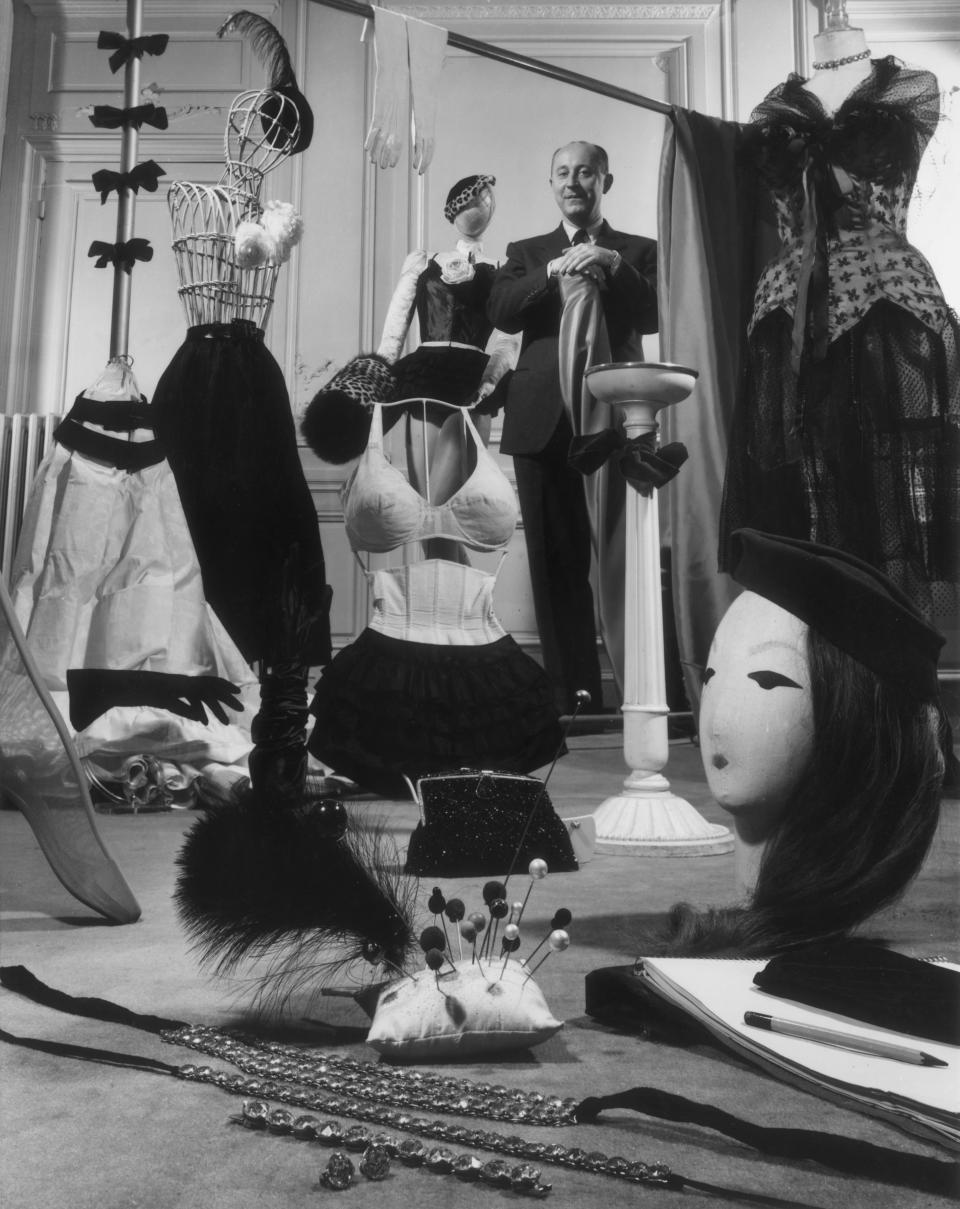
Dior was known for his impeccable taste. An invitation to his home was a coveted social coup. A famous gourmet, he would lay out lavish feasts while visitors marveled at the surroundings. Dior asked his interior decorator friends, including Victor Grandpierre and Georges Geffroy, to decorate his homes and boutiques.
The American market was a key priority, so Dior boarded the Queen Elizabeth, setting sail with Vogue’s Alexander Liberman. Upon winning the prestigious Neiman Marcus Award in Dallas in 1947, he toured Los Angeles, San Francisco, New York and Chicago, where he had a brush with angry women brandishing “Down With the New Look” placards.
Dior’s willingness to adapt his look to international markets was an innovation and is a key part of his legacy. “Thanks to both the encouragement and criticism of the buyers from abroad, I was soon designing prints for California and cottons for Rio de Janeiro in an effort to give women of different climates and different ways of life the clothes they wanted,” he wrote in his memoirs.
In 1948, the brand established a shop on Fifth Avenue in New York.
Dress manufacturers, on and off Seventh Avenue, bought dresses, the rights to reproduce designs or patterns from Dior. But there were also plenty of pirates who copied adaptations off the rack and produced them, or syndicates that rented copies to dressmakers. That meant original Dior dresses that would cost $2,000 in Paris could be copied at $7 or less.
Designs were closely guarded secrets and a threat of jail hung over employees if they leaked information about the next collection. The company was vigilant in tracking down and prosecuting copyists, averaging some 40 lawsuits a year.
Dior didn’t reap huge profits on the sale of individual models. In 1953, WWD, in a series of articles devoted to the house’s innovative business practices, pegged the margin at less than 10 percent. Dior himself elucidated his expenses in a talk with graduate students. He said that, assuming the average cost of a garment was $360, he cleared only around $30, after paying for materials, labor, social insurance, taxes and saleswomen’s commissions and overhead.
But international expansion remained brisk. Some assumed Dior, with his growing empire, would loosen his creative grip. But he refused to enter any venture in which he couldn’t wield creative influence and control distribution.
In 1950, Dior received the French Legion of Honor award for his role in the fashion and textile industry and presented a collection in London to Queen Elizabeth II and Princess Margaret.
As his responsibilities grew, he remained constant in his unwavering dedication to his craft. Before every collection, he would isolate himself for three weeks to a month and emerge with as many as 500 sketches for the new collection.
Dior had his critics. Some found his ribbed and wired creations overly complex, rigid and as unwearable as architecture. His H-line, or flat line, was controversial, as was his switch to the A-line, which some lamented for wiping out curves. In the mid-’50s, he once remarked upon the unsightliness of women’s knees and was “castigated on the front pages of five continents,” according to Collier’s.
Dior’s career encompassed only 22 collections, but the ideas behind the New Look’s body-enhancing structure reverberated for years.
The pressure of leading fashion did not escape him, and his tension was said to be palpable through the thick carpets at Avenue Montaigne. He considered his creative work nerve-racking, although at home in his bath he could churn out 100 sketches until he was as wrinkled as a prune.
“To manufacture emotion, a man must have a working agreement with madness,” he said.
Pierre Bergé recalled that Dior often instructed his chauffeur to continue circling the company’s headquarters in the black Citroën until he mustered the courage to enter. Faced with imperfections, Dior could go into a rage, poking imperfect stitches with a long stick. Withdrawn and introverted as an adult, he was said to prefer solitaire to canasta. He was also said to continue to be deeply superstitious, pessimistic and prone to consulting mediums for assurance.
By 1957, his global reputation was such that he was featured on the cover of Time magazine. The designer typically sought rest and relaxation after each collection, and in October of that year, he headed for a favorite Italian spa town, Montecatini, reportedly to lose some weight. He fell ill after dinner one night and ultimately suffered heart failure.
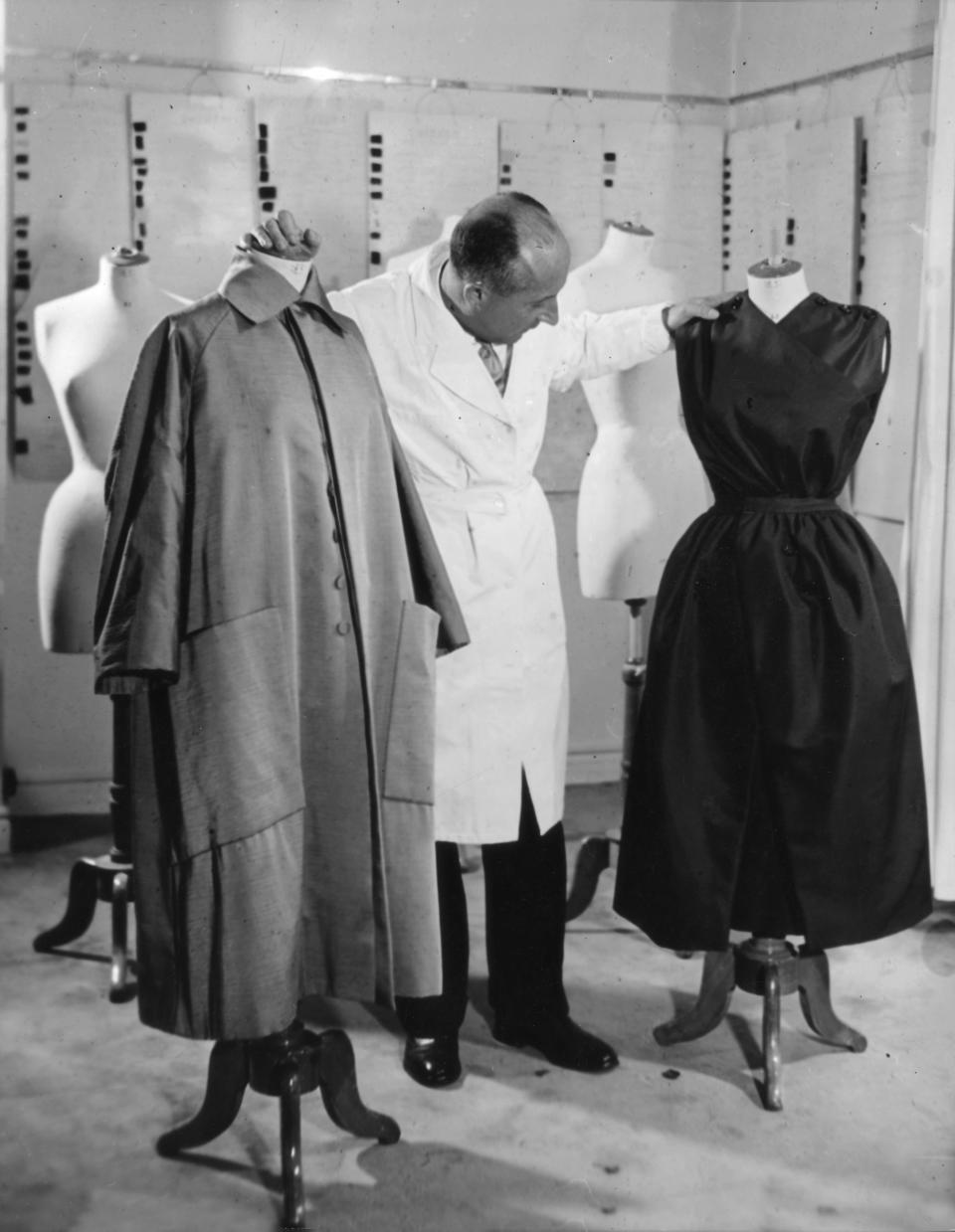
“His death was completely out of the blue,” said Jeanne Doutreleau, aka Victoire, one of Dior’s star models. Doutreleau was with Yves Saint Laurent at the Dior headquarters when she heard the news. “It was a big shock for [Saint Laurent], with the house suddenly heralding him Dior’s successor, and I remember suddenly feeling very orphaned, like the end of an era had come about,” she said.
Dior’s funeral at the Chapelle Saint Honoré d’Eylau was so packed that it took more than an hour for the congregation to pass his bier and to pay respects to family members and Dior executives. “Dior’s passing ends a brilliant career that gave the French couture and the world garment industries an impetus rarely, if ever, known before,” Balmain said in tribute.
With his inaugural Trapèze line in 1958, Saint Laurent pushed the house in a new direction. Over the years, the couturier’s successors would include Marc Bohan, Gianfranco Ferré, John Galliano, Raf Simons and Maria Grazia Chiuri, who in 2016 became the first female creative director in the history of the house.
A Timeline for Christian Dior
1905: Christian Dior is born in the French seaside town of Granville to an affluent family of agricultural industrialists.
1919: Dior meets a fortune-teller, who says he will find success through women.
1923: Dior enters a prestigious political science university in Paris.
1932: Dior and Pierre Colle open a gallery on Rue Cambacérès on the Right Bank in Paris, where they later display Surrealist works by Salvador Dalí, Alberto Giacometti, Pablo Picasso and Man Ray.
1934: Struck with tuberculosis, Dior retreats to the Pyrenees mountains and decides to turn to fashion.
1935: Dior does illustrations for the daily Le Figaro and fashion magazine Le Jardin des Modes and begins to sell drawings to couture houses including Jean Patou, Nina Ricci, Maggy Rouff and Balenciaga.
1938: Dior is hired by couturier Robert Piguet, where he creates the Café Anglais dress.
1941: Dior becomes a designer for Lucien Lelong, where he plays with pencil skirts and rounded pleats.
1946: Supported by industrialist Marcel Boussac, Christian Dior establishes the Christian Dior Couture house and opens workshops at 30 Avenue Montaigne, employing 85 people.
1947: Dior presents his first collection under his own name. Winning the Neiman Marcus “fashion Oscar” in Dallas, he tours Los Angeles, San Francisco, Chicago and New York.
1948: Christian Dior establishes a shop on Fifth Avenue in New York.
1950: Dior receives the French Legion of Honor award for his role in the fashion and textile industry and presents a collection in London to Queen Elizabeth and Princess Margaret.
Marlene Dietrich wears a Christian Dior wardrobe in Alfred Hitchcock’s movie “Stage Fright.”
1951: Staff levels at Christian Dior swell to around 900 people.
1953: Christian Dior opens a store in Caracas, Venezuela, and travels in South and Central America.
1955: Yves Saint Laurent becomes Dior’s design assistant.
The house opens a Victor Grandpierre-decorated boutique on the corner of Avenue Montaigne and Rue François I-er in Paris.
1957: Dior appears on the cover of Time magazine. The designer dies of a heart attack in Montecatini Terme, Italy.
Yves Saint Laurent becomes creative director of the fashion house.
1958: The Trapèze line of Yves Saint Laurent’s first collection marks a shift for the house. Roger Vivier launches a shoe brand under the Dior label.
1960: Marc Bohan becomes creative director of Christian Dior and later introduces the Slim Look.
1967: Philippe Guibourgé creates the Miss Dior ready-to-wear line.
Princess Grace of Monaco inaugurates the Baby Dior boutique at 28 Avenue Montaigne.
1970: Marc Bohan creates Christian Dior Monsieur.
1983: Marc Bohan wins the Golden Thimble for his spring haute couture collection.
Dominique Morlotti becomes creative director of Christian Dior Monsieur.
Bernard Arnault buys the Financière Agache group, owner of Christian Dior Couture.
1985: Bernard Arnault becomes chief executive officer of Christian Dior Couture.
1987: François Mitterrand inaugurates a retrospective exhibit at the Musée des Arts Décoratifs for the house’s 40th anniversary.
1989: Italian couturier Gianfranco Ferré becomes the designer for Christian Dior and wins the Golden Thimble for his first fall haute couture collection.
Bernard Arnault takes over the LVMH group, owner of Parfums Christian Dior, bringing couture and perfumery back under the same roof.
1992: Patrick Lavoix becomes creative director of Christian Dior Monsieur.
1995: Bernadette Chirac presents Diana, Princess of Wales, with a brand new Dior bag named Lady Dior.
1996: John Galliano succeeds Gianfranco Ferré as designer for Christian Dior.
The Metropolitan Museum of Art in New York celebrates the 50th anniversary of the house of Dior with an exhibit. At the Met Gala, Lady Diana wears the first Dior dress designed by Galliano.
1997: John Galliano presents his first haute couture collection for Dior. Nicole Kidman wears a dress from his collection at the Oscar ceremony.
The Christian Dior museum opens in Christian Dior’s family home, the Villa Les Rhumbs in Granville.
1998: Dior Joaillerie is founded with Victoire de Castellane as creative director.
2000: Hedi Slimane becomes creative director of Christian Dior Monsieur and changes its name to Dior Homme.
2007: Kris Van Assche becomes creative director of Dior Homme.
2011: Bill Gaytten becomes the designer for Christian Dior.
2012: Raf Simons is appointed creative director of womenswear for Christian Dior and presents his first haute couture collection.
2013: The Museum of Contemporary Art stages an exhibit called “The Dior Spirit” in Shanghai with over a hundred pieces from 1947 to 2013.
2016: Maria Grazia Chiuri becomes Dior’s first female creative director.
2017: The House of Dior celebrates its 70th anniversary with major exhibits in Paris and Granville, France; Melbourne, Australia; and Toronto, Canada.
2018: Kim Jones becomes artistic director of menswear at Dior.
2022: Dior reopens its historic flagship at 30 Avenue Montaigne after two years of renovations with a restaurant, a pastry café, an exhibition space, couture ateliers, a high jewelry workshop and a private apartment.
– With contributions from WWD staff.
Best of WWD

